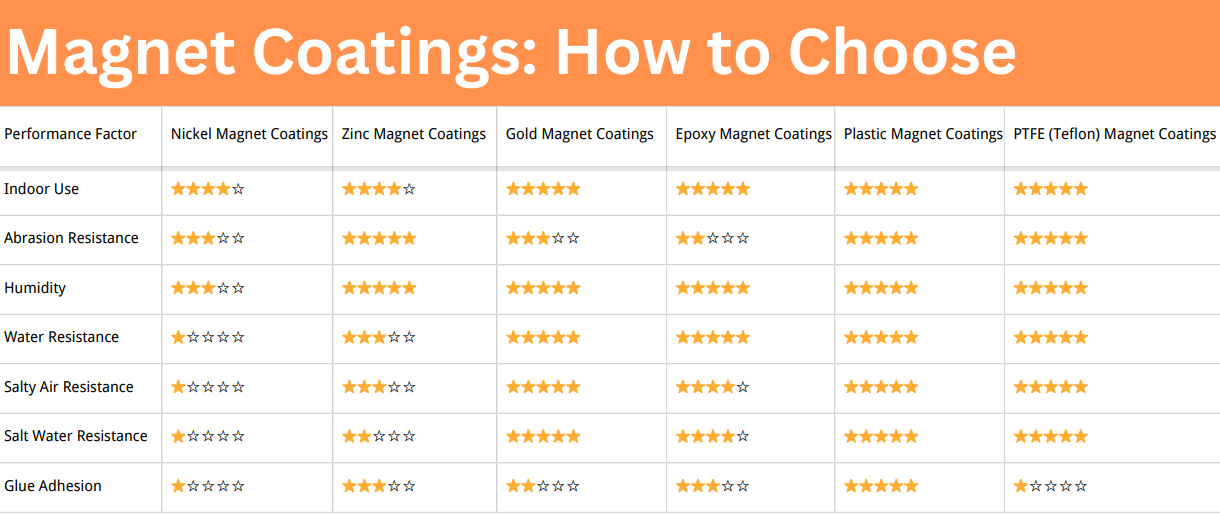Regular Surface Treatment of Neodymium Magnets
Introduction
Neodymium magnets are renowned for their superior magnetic strength and are widely used in industries ranging from consumer electronics and automotive to renewable energy and medical devices. Yet, these magnets are highly prone to corrosion and oxidation when exposed to environmental factors such as moisture, oxygen, and chemicals.
To prevent this, neodymium magnets undergo various surface treatment processes designed to protect them from environmental damage and enhance their durability. In this article, we will discuss the most common surface treatment methods used to protect neodymium magnets and their impact on performance and longevity.

Why Surface Treatment is Necessary
Neodymium magnets are primarily composed of an alloy of neodymium (Nd), iron (Fe), and boron (B), which together form a NdFeB magnetic material. While this alloy grants neodymium magnets their unmatched magnetic power, it also makes them vulnerable to oxidation and corrosion, especially in humid or chemically aggressive environments. Unprotected, these magnets can lose their magnetism, become brittle, and even break down over time. Surface treatments are crucial for mitigating these risks, ensuring that the magnets retain their functionality and strength in various applications.
Related reading: Something You Should Know About Neodymium Magnets Coatings
Common Surface Treatment Methods for Neodymium Magnets
1. Nickel-Copper-Nickel (Ni-Cu-Ni) Plating
One of the most commonly used surface treatments for neodymium magnets is nickel-copper-nickel (Ni-Cu-Ni) plating. This involves electroplating the magnet with three layers of metal—an outer and inner layer of nickel and a middle layer of copper. This multi-layer coating provides excellent protection against corrosion and wear while maintaining a smooth, metallic finish.
- Why It’s Effective: The outer layer of nickel acts as a barrier to moisture and oxygen, preventing oxidation. The copper layer adds strength and durability, making the magnet more resistant to physical wear. The final nickel layer enhances the overall protection, providing an additional barrier and improving surface finish.
- Applications: Ni-Cu-Ni plated neodymium magnets are commonly used in applications that require strong resistance to environmental factors, such as in household electronics, motors, and industrial machinery. They are also favored for their smooth surface, which is essential for precise mechanical applications.
2. Zinc (Zn) Plating
Zinc plating is another popular surface treatment used for neodymium magnets, particularly in environments where cost-effectiveness and moderate corrosion resistance are required. In this process, a thin layer of zinc is electroplated onto the magnet’s surface, providing basic protection against oxidation and wear.
- Advantages: Zinc is a less expensive alternative to nickel plating, making it an attractive option for applications where the magnets are not exposed to extreme environments. While zinc does not provide the same level of protection as nickel-copper-nickel plating, it is still effective in reducing corrosion in low-humidity or less chemically aggressive environments.
- Applications: Zinc-plated neodymium magnets are often used in general-purpose applications such as mechanical assemblies, low-cost consumer products, and areas where the magnets will not be exposed to excessive moisture or corrosive chemicals.
3. Epoxy Coating
Epoxy coating involves applying a layer of epoxy resin over the surface of the neodymium magnet, creating a strong, protective barrier. Epoxy coatings are highly effective at protecting against moisture, chemicals, and physical wear, making them ideal for harsh environments.
- Durability: Epoxy coatings offer excellent corrosion resistance and protection from water, oil, and chemical exposure. They are particularly useful in outdoor environments where magnets are exposed to the elements or in industrial applications where contact with chemicals is common.
- Limitations: One downside to epoxy coatings is that they can be brittle and may chip or crack under heavy mechanical stress. However, the protective benefits they provide in terms of corrosion and chemical resistance make them a highly effective surface treatment for many applications.
- Applications: Epoxy-coated neodymium magnets are frequently used in the automotive industry, outdoor electronic devices, and in industrial processes involving chemicals or fluids. They are also favored for use in renewable energy systems, such as wind turbines, where weather resistance is critical.
4. PTFE (Polytetrafluoroethylene) Coating
Polytetrafluoroethylene (PTFE), commonly known as Teflon, is a highly durable polymer coating known for its excellent chemical resistance and low friction properties. PTFE-coated neodymium magnets are well-suited for applications where the magnets are exposed to harsh chemicals, extreme temperatures, or environments where low friction is essential.
- Chemical Resistance: PTFE is highly resistant to a wide range of chemicals, making it an excellent choice for environments where the magnets are exposed to corrosive substances. Additionally, PTFE is hydrophobic, meaning it repels water, making it an ideal coating for marine applications.
- Low Friction: PTFE’s low-friction properties are also beneficial for applications where smooth movement is required, such as in magnetic bearings or sliding mechanisms.
- Applications: PTFE-coated neodymium magnets are commonly used in chemical processing, medical equipment, and marine environments where corrosion resistance and low friction are critical.
5. Passivation
Passivation is a chemical treatment process that creates an inert layer on the surface of the neodymium magnet, reducing its reactivity with environmental factors such as moisture and oxygen. The process involves exposing the magnet to a chemical solution that promotes the formation of a thin, passive oxide layer.
- Oxidation Prevention: The passive layer created during passivation helps prevent oxidation, effectively reducing the magnet’s susceptibility to corrosion in atmospheric conditions. This treatment is particularly beneficial in applications where the magnets are exposed to air or low levels of moisture.
- Applications: Passivated neodymium magnets are commonly used in sensitive electronic devices such as hard drives, sensors, and speakers. The passivation process ensures that the magnets retain their magnetic properties over time, even when exposed to atmospheric conditions.
Conclusion
Surface treatment is essential for the long-term performance and durability of neodymium magnets. Each surface treatment method offers distinct advantages, depending on the specific application and environment in which the magnets will operate. For instance, Ni-Cu-Ni plating is ideal for applications requiring strong corrosion resistance and durability, while PTFE coatings are preferred for environments involving harsh chemicals or extreme temperatures. Epoxy coatings provide excellent moisture resistance, and passivation helps prevent oxidation in air-exposed applications. For more information, please check Stanford Magnets.














